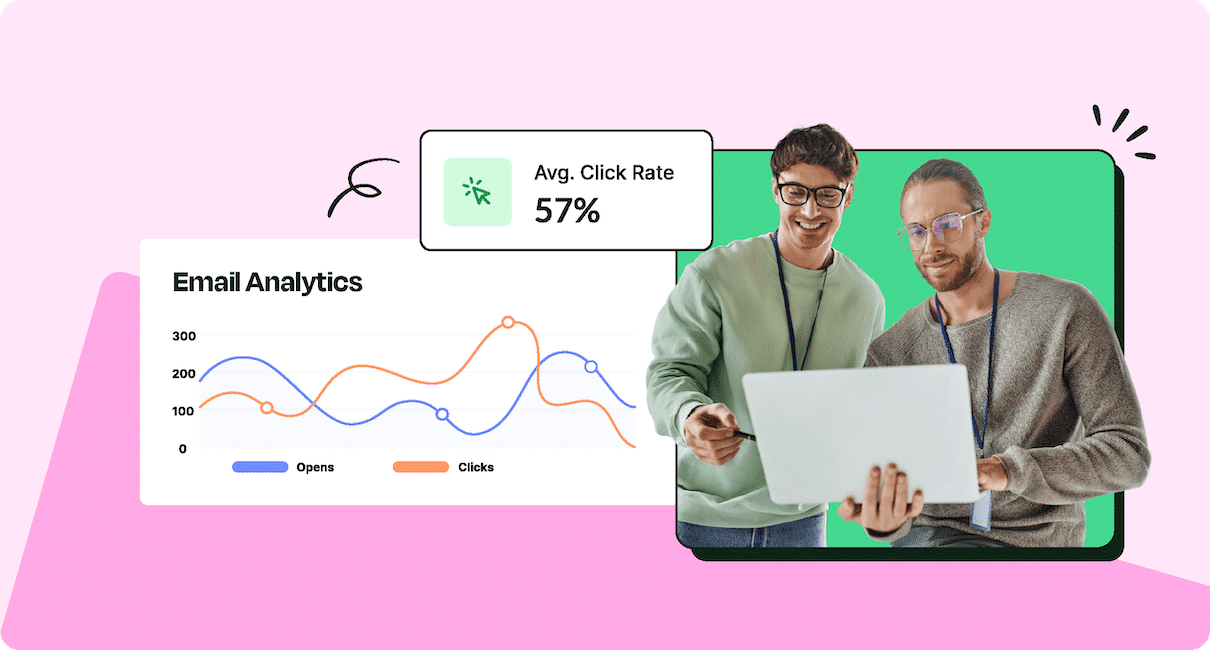Looking to optimize workforce productivity and retention? Eliminate the guesswork with an employee engagement analytics strategy that will benefit your people and your larger goals.
Every day, leaders are faced with thousands of decisions to make – from micro decisions to high-stakes plays that may be lacking data and analytics to draw from. What if we could eliminate the leaps of faith? And what happens when we equip ourselves with strong people analytics and employee engagement data to start strategically planning ahead?
In this article, we’ll unpack the importance of employee engagement data analytics, how to gather data and analyze it, and the kind of tools you can leverage for success.
Before we do, let’s cover the basics.
Take a self-guided tour of ContactMonkey
See how our key features can streamline your internal communications.
Take product tour

What is Employee Engagement Analytics?
Employee engagement analytics result from measuring and tracking the relationship between employees and your organization. This involves the practice of collecting, analyzing and interpreting data to conclude while identifying the drivers of employee engagement, retention and productivity.
In today’s workplace, employee engagement analytics are part of advanced employee management and retention strategies. They allow leaders to measure the impact of an engaged workforce through quantifiable data. By measuring employee engagement, we unlock actionable insights to be leveraged in broader business strategies and internal comms plans. This helps leadership, management and individual team members work smarter, not harder!
See how ContactMonkey’s analytics features make it easy to analyze employee engagement with emails, newsletters, and surveys.
5 Key Benefits of Employee Engagement Analytics
The key benefit of employee engagement analytics is that it takes the guesswork out of decision-making, strategizing and planning. Employee analytics equips leaders with a deep understanding of key engagement trends amongst the workforce, factors that contribute to disengagement, root causes of engagement challenges and insights into possible solutions.
Let’s walk through the key benefits of employee engagement in greater detail. Here’s why employee engagement analytics matter for any organization (and what they can do for you):
1. Gain data-driven insights needed for effective decision-making
Employee data analytics provide a clear understanding of the current level of employee engagement within an organization. This helps to identify areas of strength and weakness, allowing leaders to focus efforts on improving engagement where it’s most needed. Rather than relying on assumptions or anecdotal evidence, employee engagement analytics enables data-driven decision-making. Leaders can prioritize initiatives and allocate resources based on insights derived from quantitative and qualitative data analysis.
Wondering how? This IDP case study illustrates exactly how ContactMonkey’s email tracking feature offered the data needed to understand the impact of communications on staff members and how to make them effective. Originally, the IDP Digital Adoption Team was seeking a solution that could serve as a virtual employee engagement assistant. Its role was to identify engagement challenges and leverage the insights to develop an internal communications strategy.
With ContactMonkey’s easy access to email open rates, click-through rates (CTR), popular clicks, and read times, IDP’s team was able to zero in on challenges and opportunities for their internal communications. Using the email analytics, they were able to design more effective and engagement email templates tailored to specific counselor needs by looking at what kind of content employees opened, clicked on and read the most. Boosting internal engagement is an always-on function too for IDP and they’ve been deploying data-based designs using the simple email template builder features ever since.
Get powerful email analytics and reporting features
Know exactly who is opening and engaging with your employee communications and company newsletters.
Explore analytics & reporting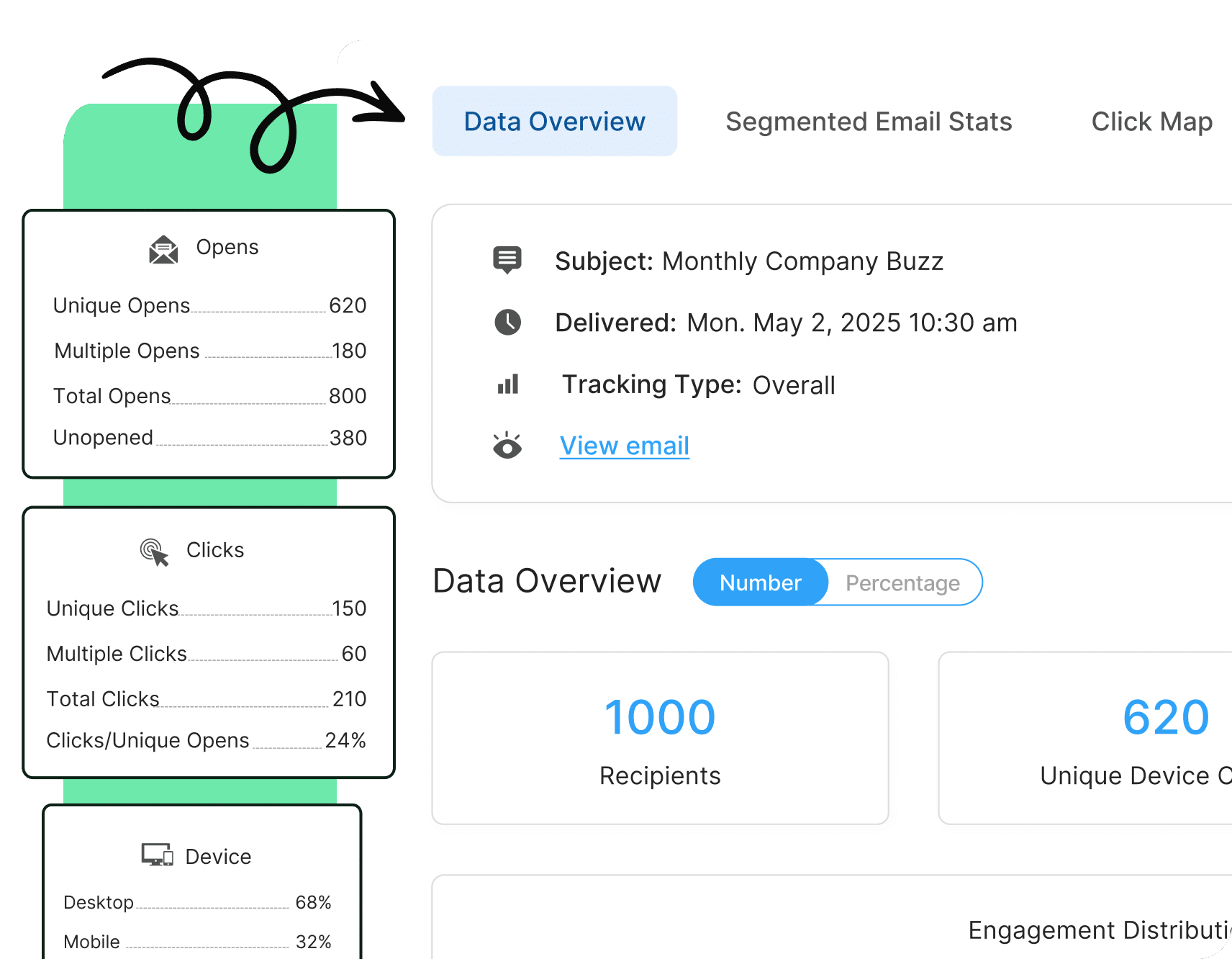
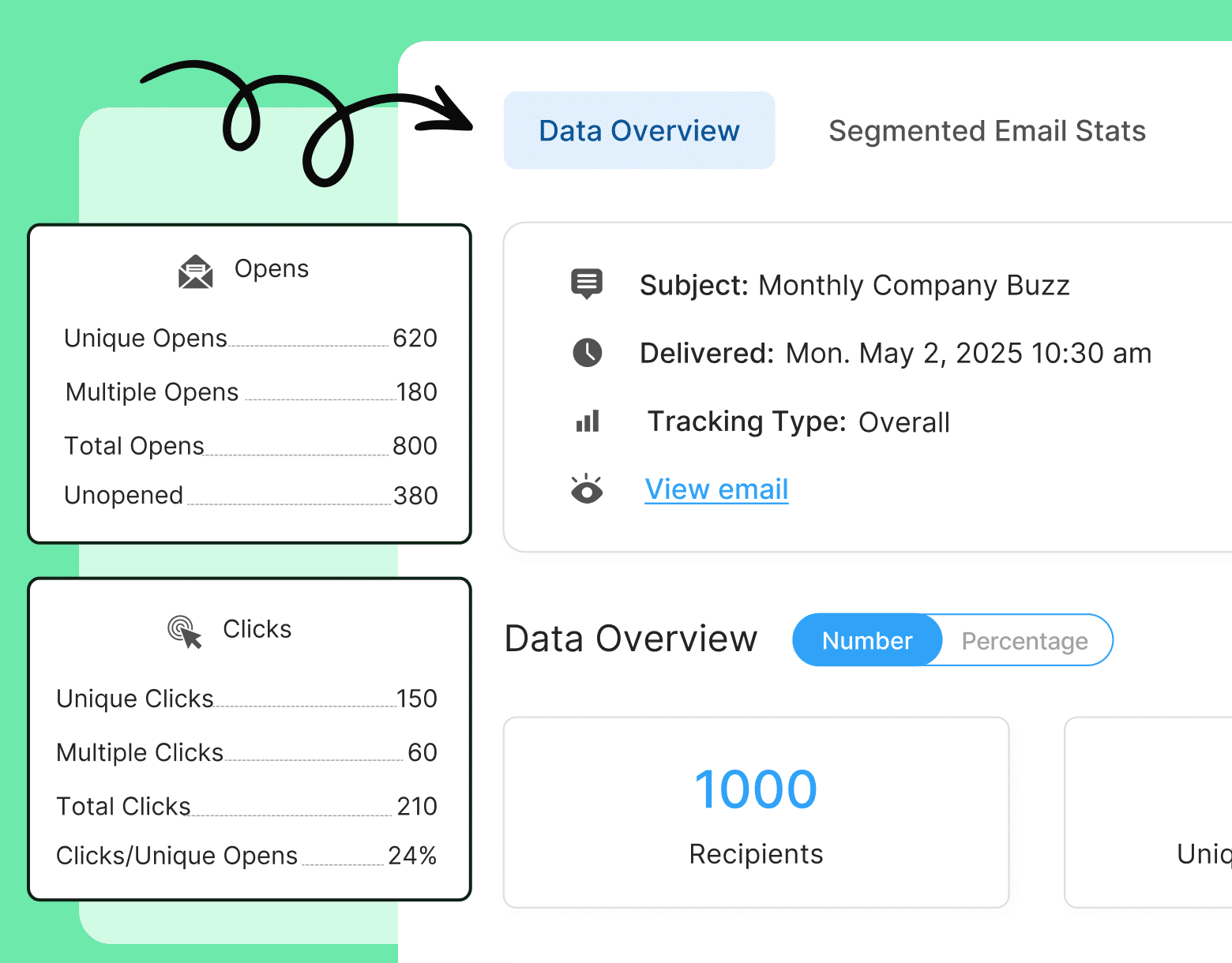
2. Identify key drivers of employee engagement (or disengagement)
Through workforce analytics, organizations can pinpoint the specific factors that influence employee engagement. This includes aspects such as leadership effectiveness, communication practices, career development opportunities, work-life balance, and organizational culture. Understanding these drivers enables targeted interventions to enhance engagement.Here are a few examples of drivers of engagement and how to measure them:
Recognition and rewards
Acknowledge employees’ hard work and achievements. Examples:
Surveys: Ask employees how often they feel recognized.
Feedback loops: Monitor formal and informal recognition patterns.
Career development
Provide opportunities for growth and advancement. Examples:
Employee growth tracking: Monitor promotions, lateral moves, and skill development.
Surveys: Gauge employee satisfaction with career advancement opportunities.
Work-life balance
Ensure employees can balance their professional and personal lives. Examples:
Time-off usage: Track vacation and sick day utilization.
Surveys: Assess employee satisfaction with work-life balance.
3. Get a forward-looking view with predictive analytics
Engagement analytics can provide predictive insights into future engagement levels based on current trends and patterns. It’s most useful to anticipate potential issues or challenges and proactively implement strategies to mitigate them, like:
- Turnover prediction: Analyzing current engagement trends, like declining satisfaction scores or increased absenteeism can predict which employees are at risk of leaving, allowing proactive retention strategies.
- Performance forecasting: Engagement metrics like recognition frequency and work-life balance can predict future productivity levels, helping leaders anticipate periods of high or low performance.
- Training effectiveness: Patterns in engagement following specific training programs can indicate the future impact of such initiatives, guiding decisions on resource allocation.
- Cultural shifts: Tracking changes in engagement across different departments or regions can predict potential cultural challenges or improvements, allowing early interventions to maintain a positive work environment.
4. Enhance overall employee experience
Improving engagement through employee experience analytics strategy contributes to a more positive and fulfilled workforce. Engaged employees tend to be more productive, committed, and satisfied with their work, which can lead to reduced turnover rates and increased retention of top talent.
Engagement analytics also support a culture of continuous improvement by providing ongoing feedback and insights for leaders to act on more quickly to course correct and double down on what’s working.
Modern internal comms and measurement tools
No design or technical expertise needed. Save time, increase engagement, and dazzle your employees with fun and interactive communications.
Explore all features

5. Translate employee engagement into business outcomes
Employee data analytics also allow organizations to establish correlations between engagement levels and key business outcomes like profitability, customer satisfaction, and innovation. To identify the correlation between employee engagement and business outcomes, you can look at:
- Engagement scores: Data from surveys, pulse checks, and sentiment analysis.
- Financial metrics: Profit margins, revenue growth, and cost savings.
- Customer satisfaction: Net Promoter Score (NPS), customer feedback, and retention rates.
- Innovation indicators: Number of new products, process improvements, and patent filings.
- Productivity metrics: Output per employee, efficiency rates, and project completion times.
When you track key metrics for employee engagement and compare them to business outcomes over a specific period, you’ll be able to identify the relationship between high levels of employee engagement and what this means for your business.
Overall, you can consider employee engagement metrics and analytics like an empowerment tool – both for leaders themselves and organizations, alike. A Gallup meta-analysis confirms that teams with high engagement levels have 23% lower turnover and 50% higher profitability than teams with low engagement levels so if we look at this data alone, the measurement efforts are worthwhile.
Use Cases for Employee Engagement Analytics at Your Company
Employee engagement analysis equips you with information you need to quickly identify, assess and respond to situations involving people practices. We get it, though – sometimes it’s challenging to know what exactly to do with the data and drive real business value.
Here are the top 3 business use cases for you to understand how to leverage employee engagement data analytics:
Analyze top engagement scores to prioritize retention investments
Who are your top performers? In what teams do employees go above beyond? Leveraging the highest engagement scores can help you understand where to prioritize your investment in top performers. Management can benefit from enablement resources to help retain these key performers and reduce costly turnover or attrition.
Example: You see that your marketing team is overperforming and you understand turnover would be costly. So, you expand your existing recognition program by offering more personalized rewards and experiences, such as professional development stipends or tailored career coaching sessions. Or, you consider investing in tools and technologies that support flexible working arrangements, promoting better work-life balance and avoiding burnout.
Learn more on using technology to increase employee engagement in your organization.
Watch ContactMonkey LIVE in action
Join live demo
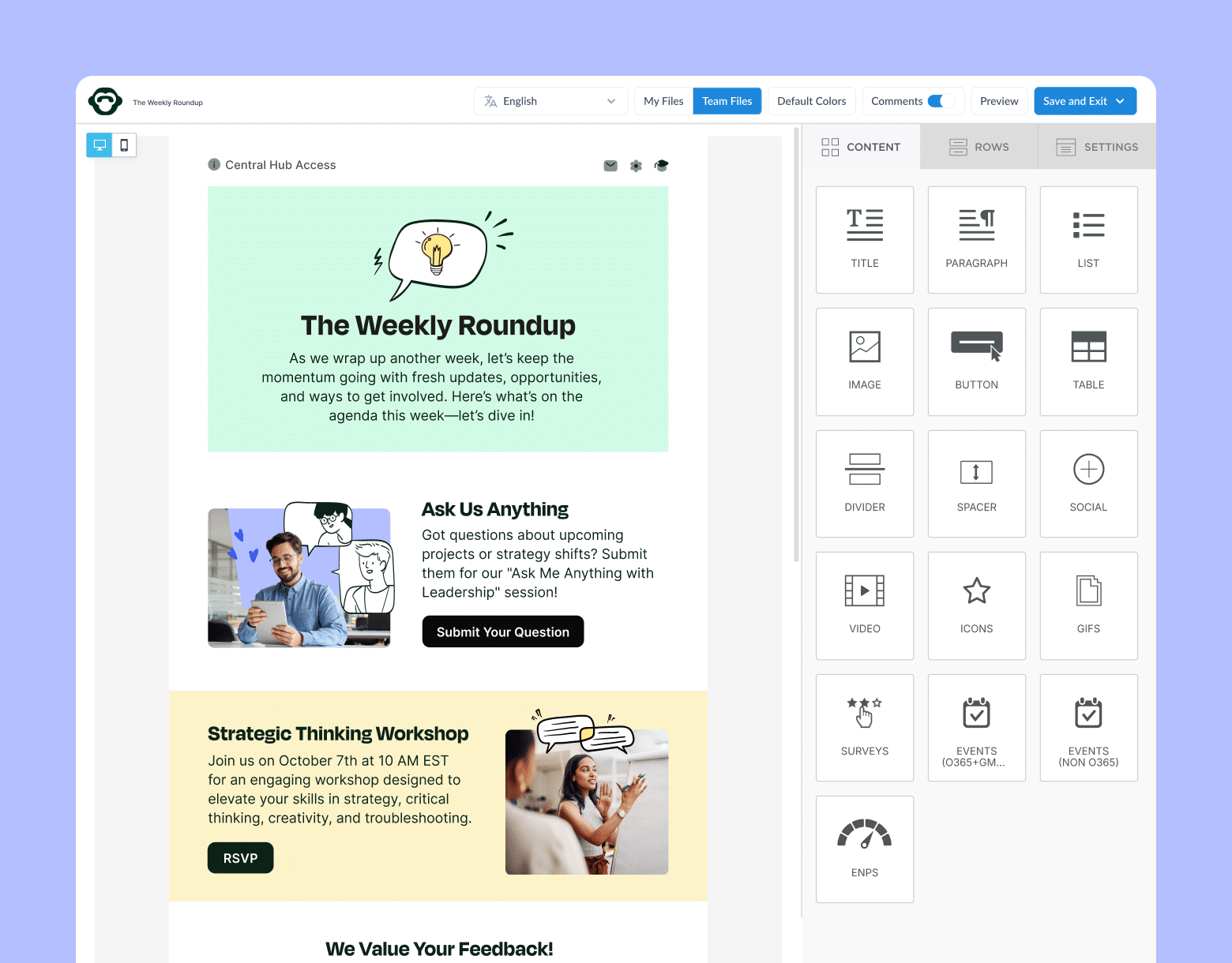
Benefit from tracking and comparing employee engagement benchmark data
Employee engagement data analytics can offer a comprehensive view of historical trend data and how engagement rates have improved, stagnated, or worsened over time. You can also evaluate your internal data against industry standards and access a clear picture of where your company stands relative to competitors. Through this exercise, you’ll be better able to prioritize interventions using data-driven decisions.
Example: You join a new company as an internal communications manager and you’re tasked with measuring employee engagement. The first thing you do is launch a global survey focusing on metrics like job satisfaction, alignment with company values, and communication effectiveness. You then purchase third-party data from an analytics firm and find that your company’s engagement levels are significantly below the benchmark in terms of communication effectiveness. This insight helps you plan for your next steps where you evaluate an investment in an internal communications tool like ContactMonkey.
Optimize workforce planning to mitigate attrition risks
Workforce planning is essential for ensuring that your company has the right people in the right roles, both now and in the future. Engagement analytics can provide valuable insights into workforce demographics and trends, helping your company plan for future needs.
Example: Take a look at engagement data alongside demographics such as age, tenure, and role and you might discover that certain groups—like employees nearing retirement age—are showing signs of disengagement. This information can inform your succession planning strategies, such as identifying and developing potential leaders, offering phased retirement options, or creating knowledge transfer programs to ensure continuity and retain valuable expertise.
What Employee Engagement Metrics and KPIs Should You Track and Measure?
Now that we’ve gone through why employee engagement analytics are important and how to use data insights effectively, let’s cover what specific metrics and KPIs to measure:
1. Employee engagement score
An employee engagement score offers insights into the overall emotional commitment of employees and is typically seen as a composite score that reflects the level of employee engagement. This score is often derived from responses to engagement surveys or assessments and provides a high-level view of employee sentiment.
Example calculation: If a survey has 10 questions and an employee answers with the following scores: 4, 5, 4, 3, 5, 5, 4, 3, 4, 5, the average score for that employee would be: 4.2. All you have to do is add up the total score and divide it by the number of questions asked (42/10 = 4.2).
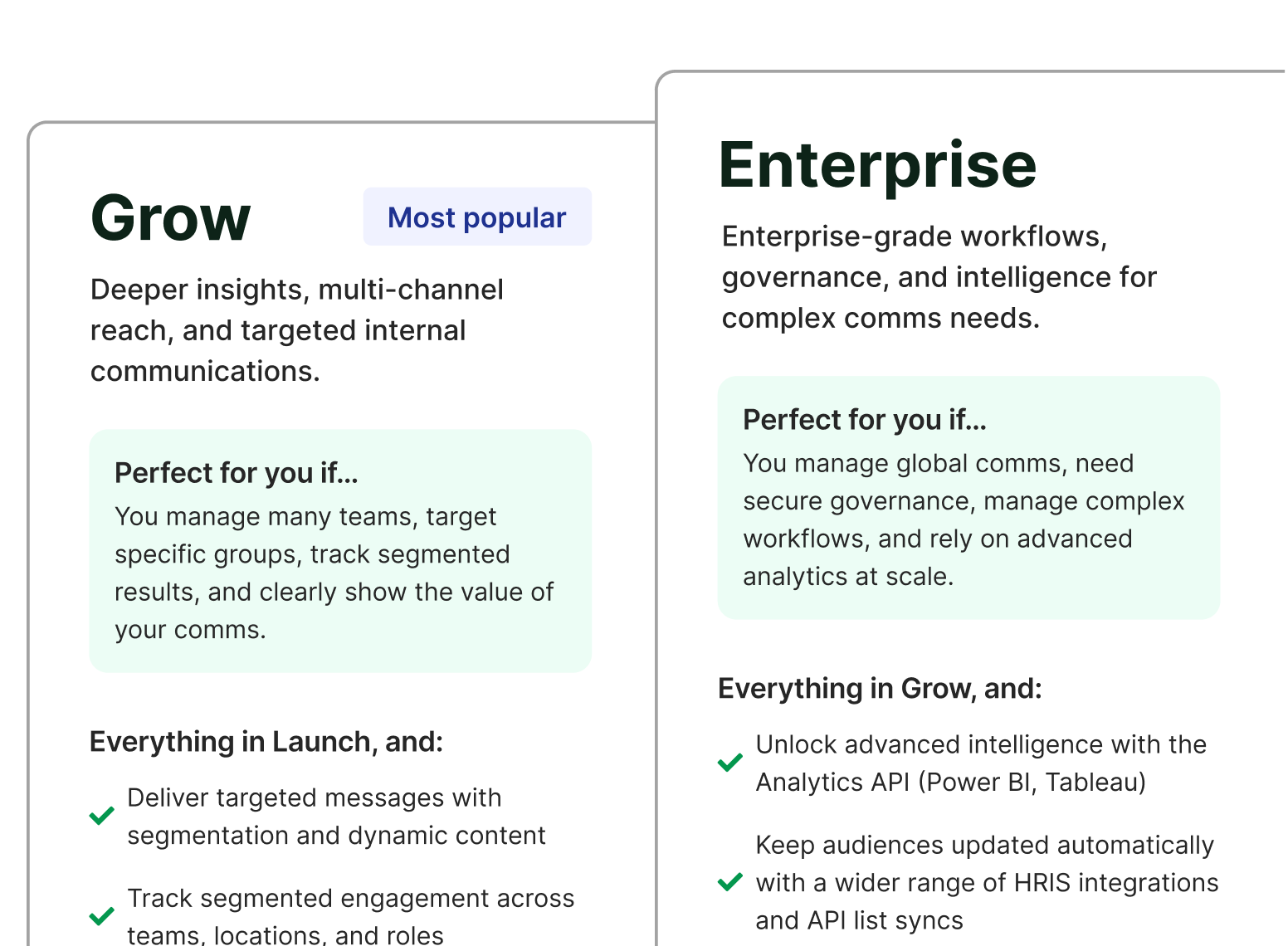
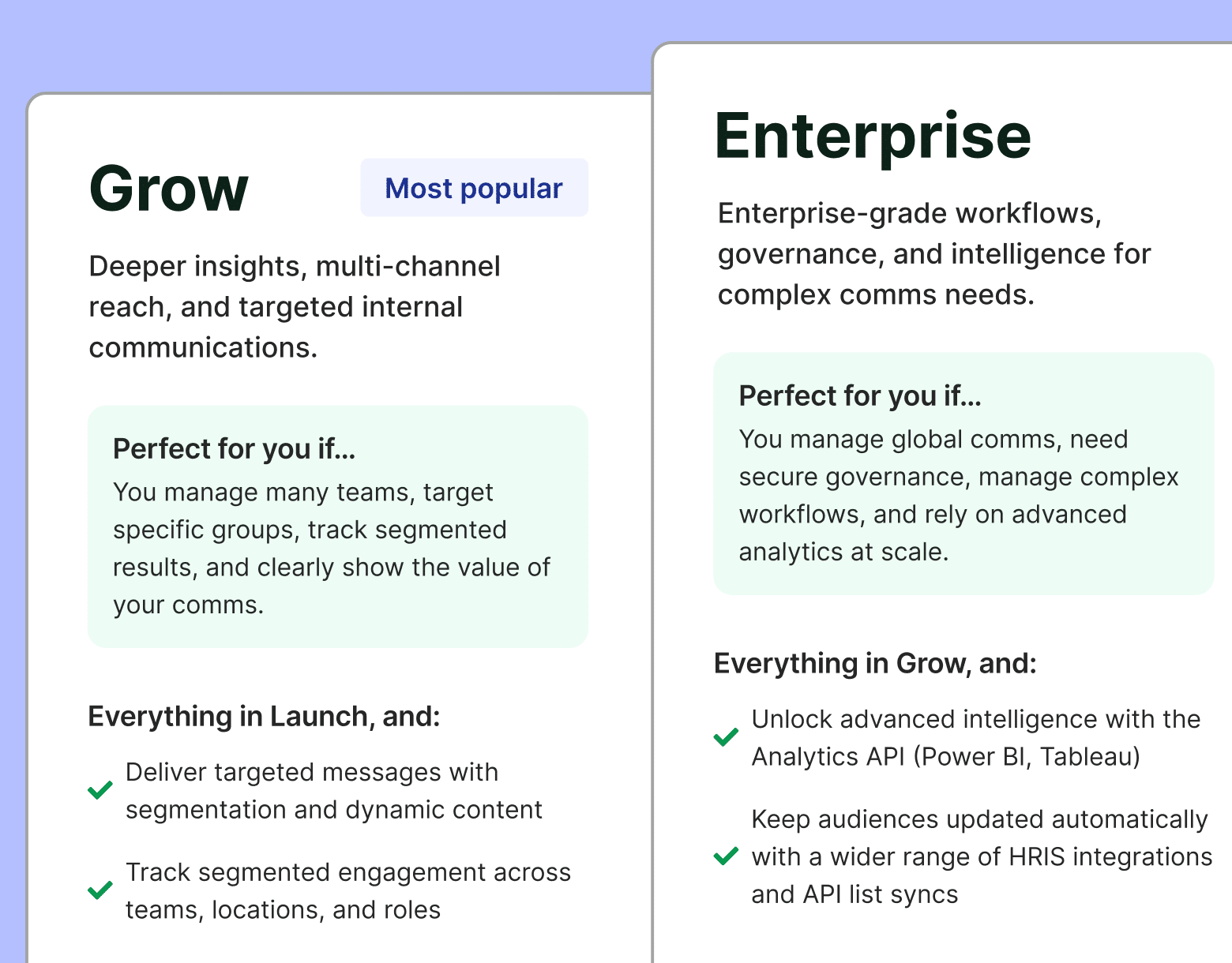
2. Employee net promoter score (eNPS)
The Employee Net Promoter Score measures the likelihood of employees recommending the organization as a place to work. The eNPS question typically asks employees:
“On a scale of 0 to 10, how likely are you to recommend our company as a place to work to a friend or colleague?”
Employees who respond with a score of 9 or 10 are considered “Promoters,” those who give a score of 7 or 8 are “Passives,” and those who rate between 0 and 6 are classified as “Detractors.” The eNPS is then calculated by subtracting the percentage of Detractors from the percentage of Promoters.
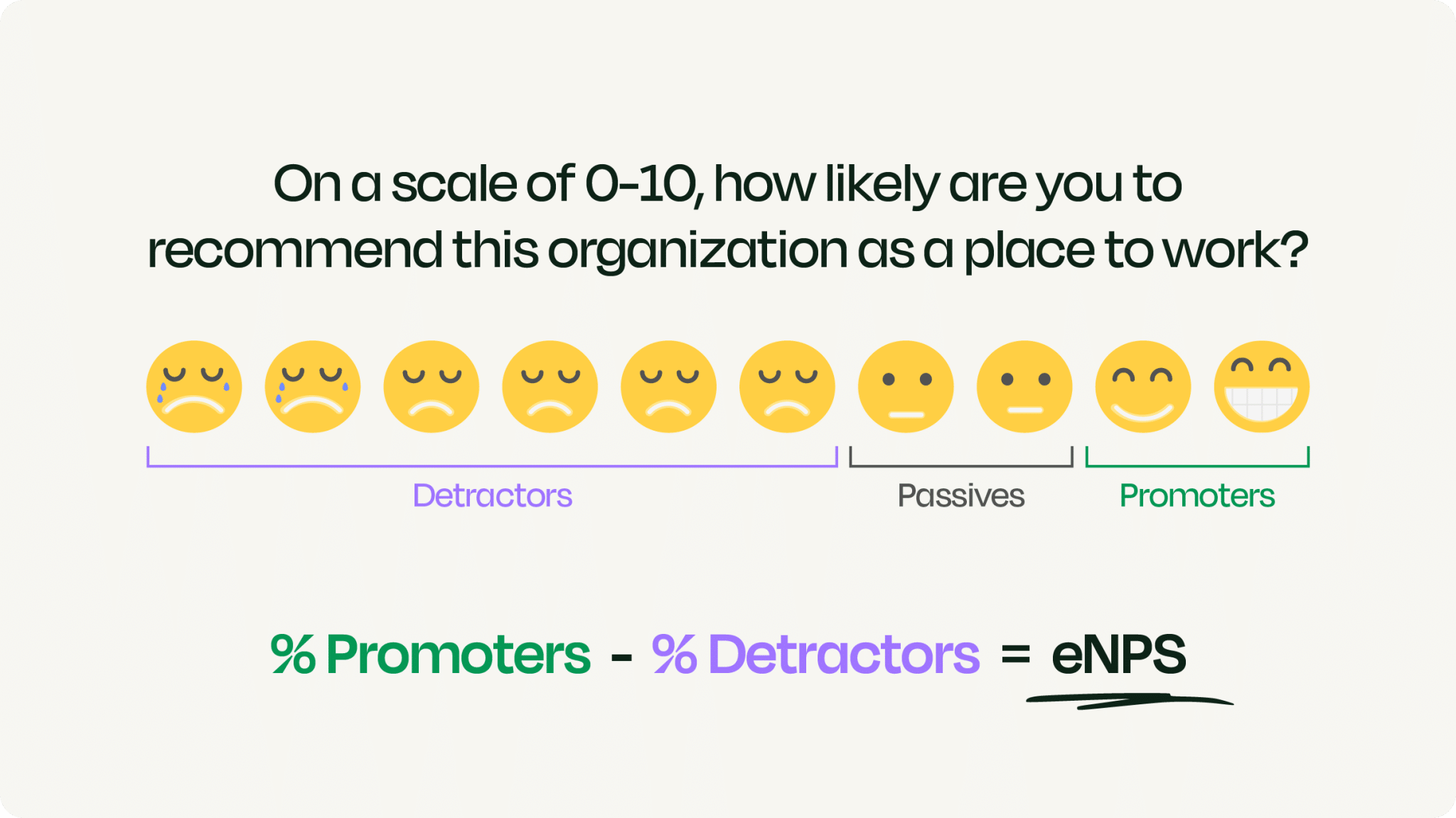
3. Survey response rate
Beyond the eNPS, overall survey responses are another metric to track. The rate at which your employees respond to your surveys is a key indicator of overall employee engagement. Examples of surveys and questions include:
Employee engagement surveys
Purpose: To measure how engaged employees are with their work and the organization.
Example questions:
- “How satisfied are you with your job role?”
- “Do you feel recognized for your work?”
- “Do you believe you have opportunities for career development?”
360-degree feedback surveys
Purpose: To collect feedback on an employee’s performance from peers, subordinates, and supervisors.
Example questions:
- “How well does this employee collaborate with others?”
- “Does this employee exhibit leadership qualities?”
- “What are this employee’s strengths and areas for improvement?”
Take a self-guided tour of ContactMonkey
See how our key features can streamline your internal communications.
Take product tour

Pulse surveys
Here are a few examples of drivers of engagement and how to measure them:
Purpose: To gather quick, frequent insights on employee sentiment or specific issues.
Example questions:
- “How would you rate your job satisfaction this week?”
- “Do you feel supported by your manager this month?”
- “Is your current workload manageable?”
- “How confident are you in the company’s direction?”
PRO TIP: With ContactMonkey, you can easily embed surveys into your internal e-mails using our email template builder and access your employees’ responses within your analytics dashboard for a seamless experience.
4. Internal newsletter engagement
Survey response rates and employee engagement survey analysis offer you a glimpse into the effectiveness of your internal comms. However, measuring newsletter engagement holistically will lead to a more comprehensive assessment on total engagement for internal comms.
Examples of key email metrics include:
Open rate
- What it measures: The percentage of recipients who open an email.
- Why it matters: Open rate indicates how compelling your subject lines are and the initial interest in your emails.
Click-through rate (CTR)
- What it measures: The percentage of recipients who clicked on one or more links in your email.
- Why it matters: CTR helps gauge the effectiveness of your email content and the relevance of your call-to-action (CTA).
Conversion rate
- What it measures: The percentage of recipients who completed a desired action (e.g., making a purchase or signing up for a webinar) after clicking on a link in your email.
- Why it matters: Conversion rate measures the ultimate success of your email campaign in achieving its objectives.
Click maps
- What they measure: Click maps provide a visual representation of where recipients clicked within your email, showing which links, buttons, or images received the most interaction.
- Why they matter: Click maps help you understand the effectiveness of your email design and layout by revealing which elements attract the most attention. This insight can be used to optimize future emails, improving the placement of key links and CTAs to enhance engagement.
Using an effective internal communication tool like ContactMonkey, you can access data and analytics that show you who your most engaged employees are, e-mail read time, open and click rates, and more. With more detailed metrics, you can determine your best-performing content and understand what kind of information your employees are interested in. Think of ContactMonkey as your primary employee engagement analysis tool for internal communications.
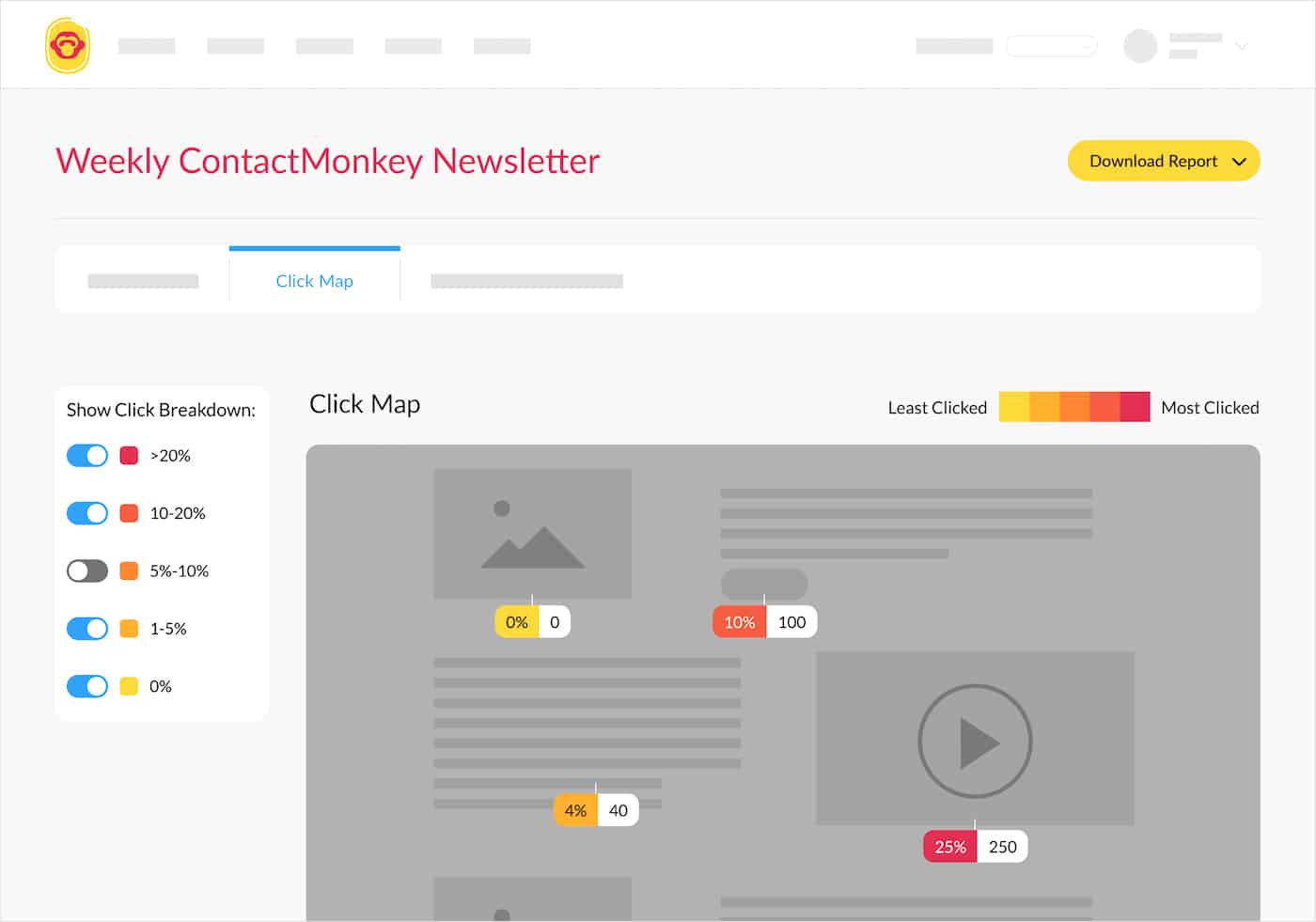
5. Employee satisfaction index (ESI)
The ESI is a metric used to gauge the overall satisfaction of employees within an organization. It’s derived from survey responses that assess various aspects of an employee’s job and workplace experience, including factors such as the work environment, compensation, role clarity, work-life balance, career development opportunities, and leadership effectiveness.
Example questions include:
Work environment
- “How satisfied are you with the physical work environment (e.g., office space, tools, and resources) provided by the company?”
- “Do you feel that your workplace fosters a positive and inclusive culture?”
Compensation and benefits
- “How satisfied are you with your current compensation (salary, bonuses) relative to your job responsibilities?”
- “How satisfied are you with the benefits package (health insurance, retirement plans, etc.) offered by the company?”
Role clarity
- “Do you clearly understand your job responsibilities and what is expected of you?”
- “How well does your role align with your skills and career goals?”
Career development
- “How satisfied are you with the opportunities for professional growth and career advancement at this company?”
- “Do you feel that the company provides sufficient training and development opportunities?”
Start two-way conversations and employee feedback loops
Learn how to engage staff with pulse surveys, content ratings and reactions, custom polls, and more. Ready to send modern emails?
See engagement features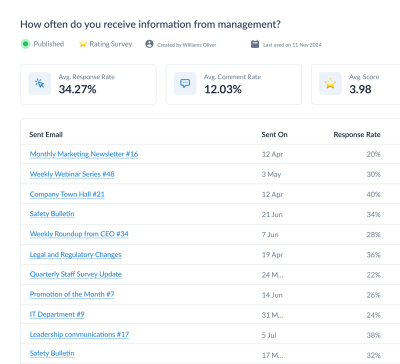
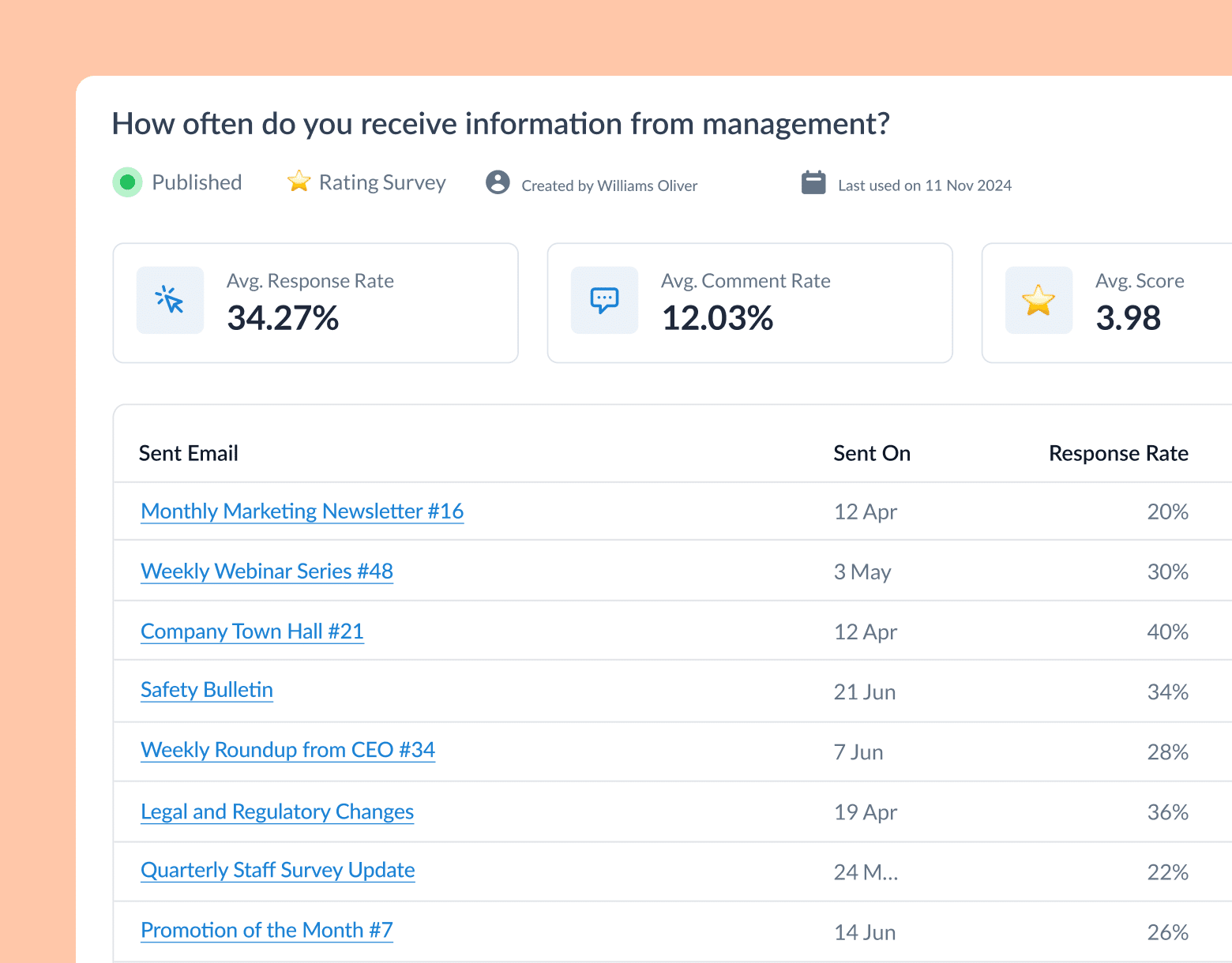
How to Obtain Data on Employee Engagement
Employee engagement data can be gathered using both quantitative and qualitative methods – both of which can benefit from data analysis of employee engagement metrics to offer real value.
Types of data collection tools for employee engagement – quantitative
- Employee engagement surveys: Conduct regular surveys specifically designed to assess employee engagement. These surveys typically include questions about job satisfaction, work environment, leadership effectiveness, communication, recognition, and growth opportunities. Then, use employee engagement survey analytics to understand the results.
- Pulse surveys: Short, frequent surveys conducted at regular intervals (e.g., monthly or quarterly) to capture real-time feedback on specific topics related to employee engagement, organizational changes, or initiatives.
- Employee engagement and analytics platforms: Using a specialized internal communications platform like ContactMonkey allows you to measure and analyze staff engagement data, launch automated surveys and access insights through dashboards. You can also segment your audience based on their engagement levels, interests, or roles, allowing for more personalized and effective comms.
Employee engagement data collection – qualitative
- One-on-one interviews or focus groups: Conduct interviews or focus groups with employees to gather in-depth qualitative insights into their experiences, perceptions, and suggestions for improving engagement.
- Performance reviews: Incorporate questions related to engagement in performance reviews or feedback sessions with employees and managers. You can also gather feedback from peers, direct reports, and managers to gain a comprehensive view of an employee’s engagement levels through 360-degree feedback.
- Exit interviews: When employees choose to leave an organization, exit interviews can help you understand reasons for leaving, including factors related to overall engagement and satisfaction.
Remember, to encourage honesty, it’s important to preserve confidentiality. You can do this with ContactMonkey which lets you combine anonymity with powerful analytics, unlike other survey platforms. Best of all, it offers that critical analysis of employee engagement metrics that you’ll need to build business cases and make smart decisions.
How to leverage analytics for your employee engagement strategy
Leveraging analytics for your employee engagement strategy involves using data to understand employee behaviors, preferences, and needs. By analyzing this data, you can make informed decisions that enhance employee satisfaction, productivity, and retention. Here’s how you can do this, along with some practical examples:
Identify and track key metrics
Example: Monitor metrics like employee turnover, absenteeism, and engagement survey results. A high turnover rate in a specific department could signal underlying issues that need attention.
Conduct regular surveys
Example: Use pulse surveys to regularly assess employee sentiment. A low satisfaction with career development might lead to implementing more training programs.
Segment employee data
Example: Break down data by department or role to spot trends. If remote employees show lower engagement, consider enhancing communication or support.
Leverage predictive analytics
Example: Use analytics to predict potential issues, like identifying employees at risk of leaving, so you can proactively address concerns.
Act on insights
Example: If data shows a dip in morale during a busy season, introduce wellness initiatives or flexible working hours to boost engagement.
ContactMonkey offers comprehensive employee engagement reporting and analytics so you can create customized reports to share with your leadership team. You can access historical trend data, email engagement rates and average read times, allowing you to build reports based on the information most relevant to you and your organization.
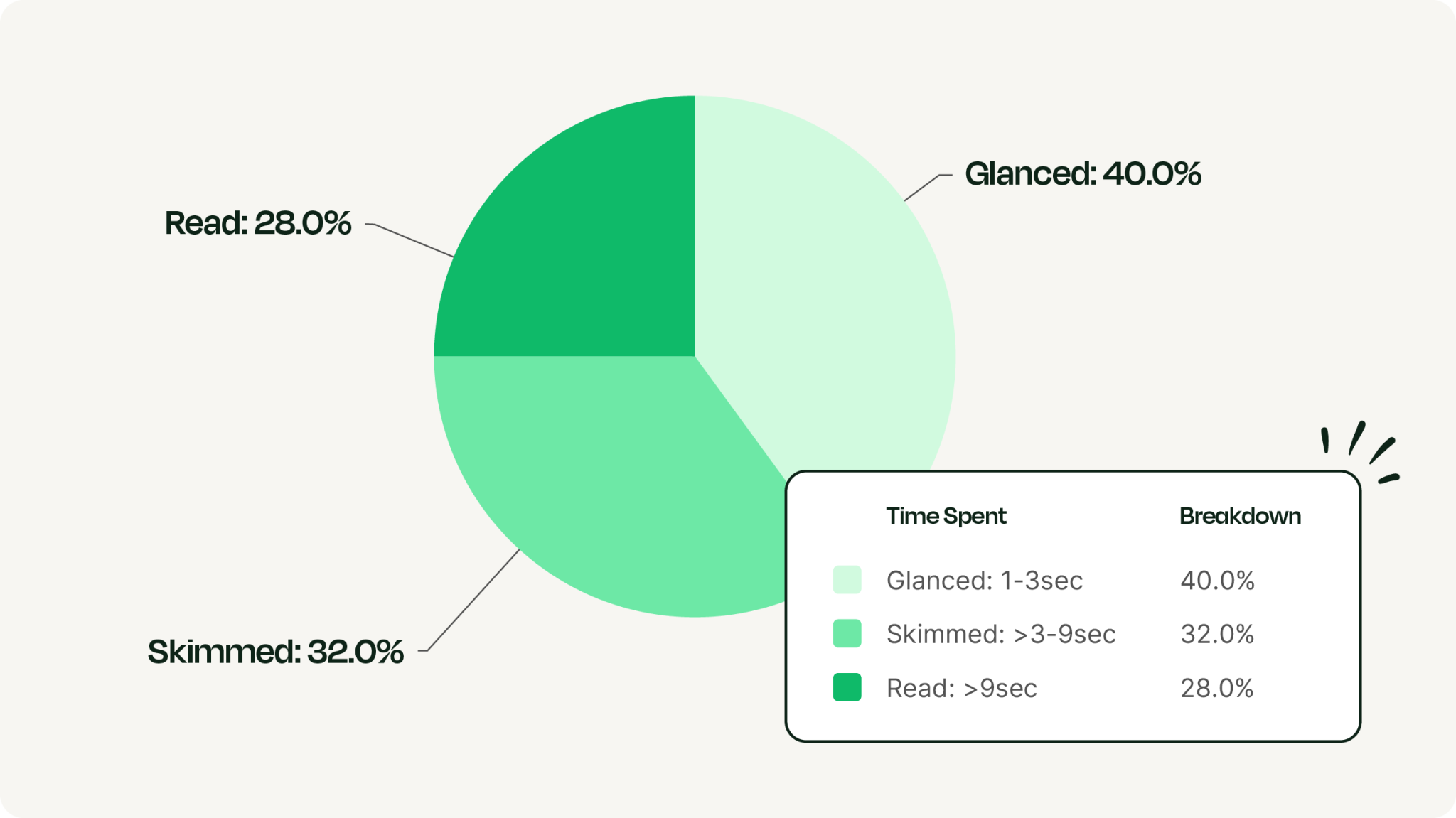
How Can AI Help You with Employee Engagement Analytics?
As AI has evolved over the past year and more, it’s begun to transform employee engagement analytics by enabling organizations to gain deeper, more actionable insights into their workforce.
With AI’s ability to analyze what’s happening in the present through descriptive analytics, you can gain a solid understanding of your current state of employee engagement. Even better – the role of AI in employee engagement analytics can be considered a crystal ball. AI can also help you anticipate future trends and take proactive measures through predictive analytics of employee engagement. You can even access support with employee engagement culture analytics, employee behavior analytics, and content engagement analytics.
Here’s more on how you can use AI to help you better use employee engagement analytics to drive business performance:
- Real-time analysis: AI enables continuous, real-time monitoring of employee engagement, moving beyond the limited insights provided by traditional annual surveys.
- Data processing: AI can analyze large volumes of data from various sources, such as surveys, emails, social media, and performance metrics, providing a comprehensive view of employee engagement.
- Pattern and trend identification: Another example of how AI algorithms, including natural language processing (NLP), can detect patterns and trends in employee sentiment that may not be obvious through traditional methods.
- Predictive analytics: AI can forecast future engagement levels by analyzing historical data and current trends, helping organizations anticipate and address potential issues before they become problematic.
- Proactive interventions: AI-driven insights allow HR and internal comms teams to implement early interventions, improving employee satisfaction and reducing turnover.
- Personalized analytics: AI can tailor engagement insights to individual employees, offering more precise and actionable feedback.
All these capabilities allow organizations to anticipate issues and proactively implement strategies by using data to improve employee engagement.
Say yes to help from AI!
Create and send employee surveys for feedback
Engage staff with pulse surveys, eNPS surveys, reusable surveys, custom polls, and more. Ready to send modern emails?
Explore survey features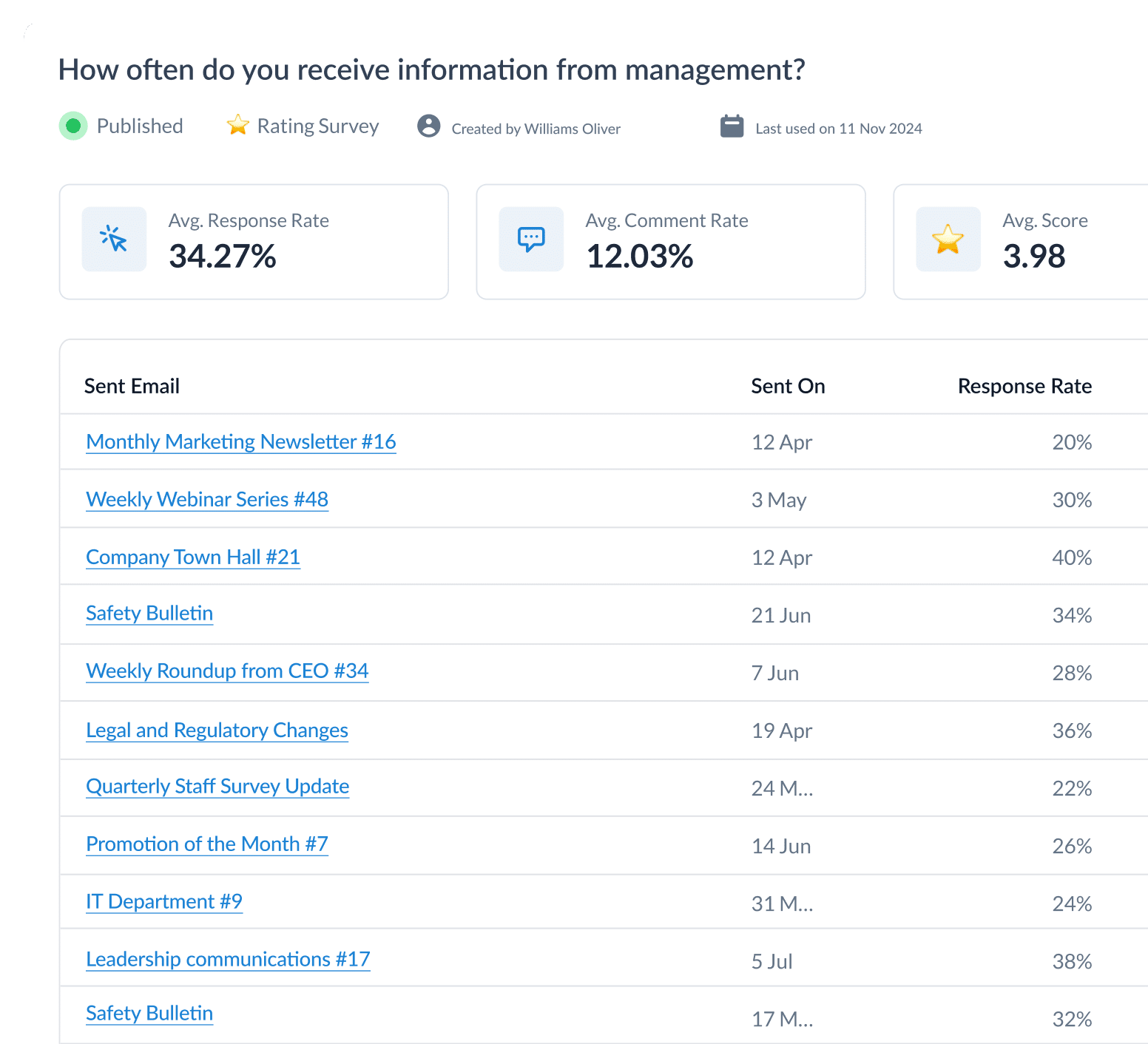

How to Develop an Employee Engagement Data Analytics Strategy
1. Define clear objectives
Identify key goals: What do you want to achieve with your employee engagement data? Examples might include improving retention rates, increasing productivity, or enhancing workplace culture.
Align with business objectives: Ensure that your engagement goals support broader company objectives.
2. Determine key metrics
Choose relevant metrics: Common metrics include employee satisfaction scores, turnover rates, absenteeism, and feedback from engagement surveys.
Benchmarking: Compare your metrics against industry standards or internal benchmarks to assess performance.
3. Collect data through employee feedback methods
Surveys and questionnaires: Regularly conduct employee engagement surveys. Use both quantitative (e.g., Likert scales) and qualitative (e.g., open-ended questions) methods.
Pulse Surveys: Implement shorter, more frequent surveys to capture real-time data on engagement.
4. Leverage technology and tools
HR analytics platforms: Use tools like People Analytics or HRIS systems to collect and analyze data efficiently.
Integration with internal email tools: Ensure that your engagement data is integrated with other HR data and internal communication tools for a comprehensive view.
5. Conduct data analysis and interpretation of the data
Data segmentation: Break down data by department, tenure, role, or other relevant factors to identify patterns and trends.
Predictive analytics: Use advanced analytics to predict future trends in engagement and potential risks, such as high turnover in specific departments.
6. Develop actionable insights
Identify key drivers: Determine the primary factors influencing employee engagement. This could be leadership, work-life balance, or career development opportunities.
Action plans: Develop specific action plans to address areas of concern. For example, if feedback indicates a lack of career development opportunities, you might develop new training programs.
7. Implement strategies and communicate with stakeholders
Engage stakeholders: Involve leadership, HR, and line managers in the implementation of action plans.
Transparent communication: Share findings and action plans with employees to build trust and demonstrate commitment to improvement.
8. Monitor and adjust strategies and tactics
Continuous monitoring: Regularly review engagement data to assess the effectiveness of your strategies.
Adapt and evolve: Be prepared to adjust your strategy based on new data or changes in the workplace environment.
9. Generate an ongoing feedback loop
Employee involvement: Continuously involve employees in the process, asking for their feedback on the changes being implemented.
Iterative process: Treat employee engagement as an ongoing process, not a one-time project. Continuously refine your strategy based on feedback and results.
10. Offer training for data literacy
Upskill HR and managers: Ensure that HR teams and managers are trained in data literacy so they can effectively interpret and use engagement data.
Build a data-driven culture: Foster a culture where data-driven decision-making is encouraged and supported. Provide workshops or resources to help employees at all levels understand the importance of data in driving engagement.
Implement Employee Engagement Data Analytics Today with ContactMonkey
Now that we’ve well understood why employee data analytics are critical to sustaining engagement, is your team benefiting yet? Decisions powered by data build the strongest narratives and can equip you with the knowledge to better understand employee engagement at your organization.
Internal email software serves as an enabler for an organization’s engagement strategy. ContactMonkey makes it easy for you to launch engagement initiatives, plus measure, analyze, and report on employee engagement. And, don’t forget to bookmark this article so you can refer back for tips on how to strategically leverage data analytics and tools in the future.
Accessing data-driven insights helps you act on the right insights at the right time. This way, you’ll keep your employees engaged and your customers happy too.
Ready to get serious about your internal communications and engagement analytics? Get an inside glimpse into ContactMonkey by booking a free demo today!

